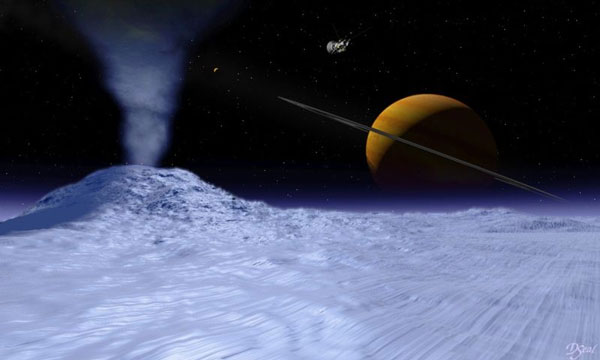Found a source of rain on Saturn
Observations of the European Herchel Space Observatory show that it was water fired from Enceladus satellite that created circles of water clouds around Saturn. This discovery has a 14-year secret code of water origin in the second-largest planetary planetary solar system, Physorg said.
In 1997, the European Infrared Ray Observatory discovered steam in Saturn's atmosphere. Later, NASA / ESA Cassini / Huygens probes found faucets on Saturn's Enceladus moon. However, the fact remains unclear so far.
The latest images of the Observatory introduced into space since 2009 show that Enceladus is the only known satellite in the Solar System that affects the chemical composition of its host planet.

At least four water taps fired from Saturn's southernmost region of Enceladus,
it is this water that creates steam circles around Saturn
which we have discovered so far.Photo: NASA.
Every second, the moon Enceladus shoots 250 kilograms of steam through a collection of nozzles in its southernmost region. This southern polar region is known as Tiger Stripes (Tiger Stripes) due to characteristic surface marks.
The results of computer analysis from Herschel's latest observations have shown that most of Enceladus's water splashes into space, freezing on air rings in space or falling down to satellites. Another of Saturn.
Only about 3-5% of that water will eventually fall into the outer planet of Saturn, creating a circular steam circle around the host planet. The whole width of that steam ring is about 10 times the radius of Saturn, but it is only as thick as Saturn. The moon Enceladus orbits Saturn's planet at a distance of four times the radius of Saturn, and thus continually repeats the water vapor.
Despite its enormous size, the steam ring surrounding Saturn has recently been discovered because light is often unable to detect transparent water vapor but the infrared waves of the Herchel Observatory are detectable. them. It is this ring of water outside the Earth's atmosphere that produces rain in the gaseous form in the interior layers of gas.
Water in Saturn's outer space over time is introduced into the lower layers, where they will solidify into clouds but these clouds are so small that they cannot be observed. It is this water that produces oxygen compounds, like CO 2 in Saturn's atmosphere.
'For the earth, there is no such resemblance', Paul Hartogh, Max-Planck-Institut für Sonnensystemforschung, Katlenburg-Lindau in Germany, analysts said. 'That amount of water is too small to penetrate our atmosphere from the universe. The case of Saturn's rain catch is unique '.
'Once again we see the value of Herschel Observatory. There are many observations that Herschel can only see, ' said Goran Pilbratt, a famous scientist from the European Space Observatory.
- Video: The rain of diamonds on Saturn is amazing
- Discovering diamond rain on Jupiter and Saturn
- Titan Saturn Moon: 1,000 years a rain
- Hail found from Saturn's belt
- Overview of Saturn
- Unseen images of Saturn's belt
- What's interesting on Saturn?
- Signs of water on Saturn satellite
- 1000 tons of diamonds poured down on Saturn and Jupiter every year
- Saturn changes color seasonally
- Determine the true age of Saturn's belt
- The last photos of Cassini in the Saturn mission
 Van Allen's belt and evidence that the Apollo 11 mission to the Moon was myth
Van Allen's belt and evidence that the Apollo 11 mission to the Moon was myth The levels of civilization in the universe (Kardashev scale)
The levels of civilization in the universe (Kardashev scale) Today Mars, the sun and the Earth are aligned
Today Mars, the sun and the Earth are aligned The Amazon owner announced a secret plan to build a space base for thousands of people
The Amazon owner announced a secret plan to build a space base for thousands of people